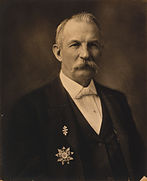United States House election, 1900
|
|
|||||||||||||||||||||||||||||||||
|---|---|---|---|---|---|---|---|---|---|---|---|---|---|---|---|---|---|---|---|---|---|---|---|---|---|---|---|---|---|---|---|---|---|
|
|||||||||||||||||||||||||||||||||
|
All 357 seats to the United States House of Representatives 179 seats needed for a majority |
|||||||||||||||||||||||||||||||||
|
|||||||||||||||||||||||||||||||||
|
|||||||||||||||||||||||||||||||||
Elections to the United States House of Representatives were held in 1900 for members of the 57th Congress, coinciding with the re-election of President William McKinley.
McKinley's Republican Party gained thirteen seats from the Democratic Party and minor parties, cementing their majority. A reassertion of Republican control in the Mid-Atlantic was key in the gain of new seats. However, with an improved economy, especially in the industrial sector, the election cycle featured no keystone issue, resulting in a general support for the status quo. The fading Populist Party held on to five House seats, while the sole member of the Silver Party changed parties to Democratic.
The previous election of 1898 saw the election of 6 Populists, 2 Silver Republicans, and a Silver Party member.
In 1900, three states, with 8 seats among them, held elections early:
Party abbreviations
J. William Stokes (D) of the 7th district died in office on July 6, 1901 and was replaced in a special election by Asbury F. Lever (D)
...
Wikipedia



